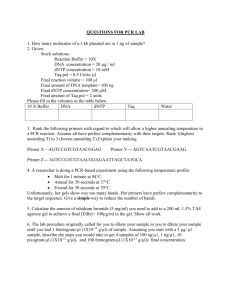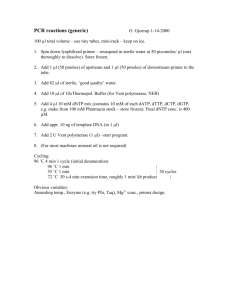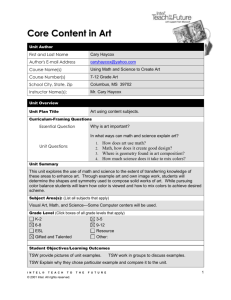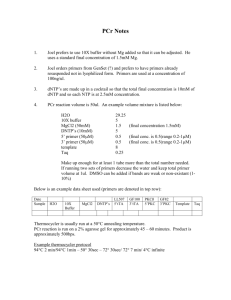Mutagenesis by Expanded DNA Precursor Pools of Mammalian Cells
advertisement
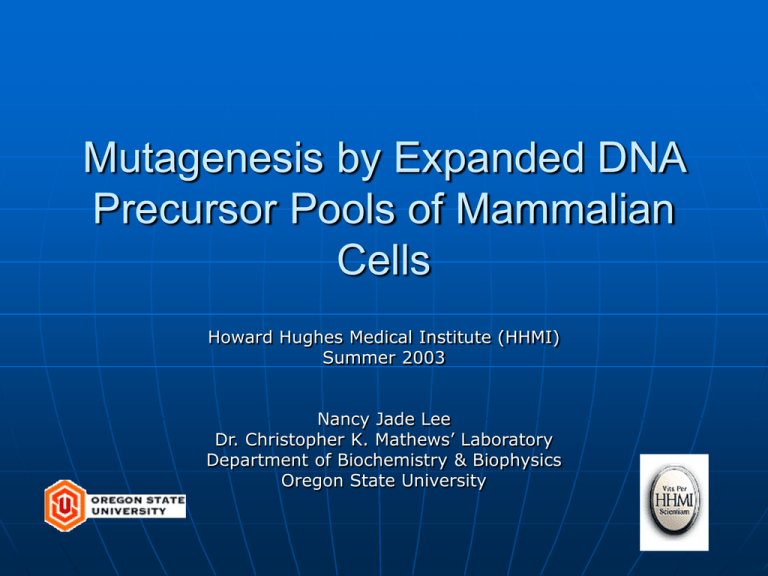
Mutagenesis by Expanded DNA Precursor Pools of Mammalian Cells Howard Hughes Medical Institute (HHMI) Summer 2003 Nancy Jade Lee Dr. Christopher K. Mathews’ Laboratory Department of Biochemistry & Biophysics Oregon State University Lab Objectives To understand mechanisms of mutagenesis caused by perturbations of nucleotide metabolism To understand the source and regulation of DNA precursor pools in mitochondria and eukaryotic cells To understand how enzymes of DNA precursor synthesis interact within cells to facilitate the flow of nucleotides into DNA My Objectives To examine DNA precursors (Deoxyribonucleotides or dNTPs) and their ability to stimulate mutagenesis To understand the relationship between intracellular DNA precursor concentration and mutagenesis To study the effects of hydroxyurea on ribonucleotide reductase (rNDP reductase) in mammalian cells in order to understand the role of rNDP reductase Importance Cancer results from mutations that accumulate in pre-cancerous cells (Loeb, 1998) • Tumor cells in culture tend to have higher levels of dNTPs than non-tumor cells (Martomo & Mathews, 2002) Background Deoxyribonucleotides (dNTPs) are necessary for biosynthesis of DNA dATP dTTP dCTP dGTP *The amount of each dNTP contained in a cell is referred to as a “pool” (Images courtesy of www.fermentas.com) dNTP Pools Regular cells have balanced pool sizes Unbalanced dNTP pools can stimulate mutagenesis (Kunz et al, 1994) Example dATP pool dTTP pool dGTP pool dCTP pool = more mutations Meanwhile… In E. coli cells balanced increases in dNTP pools also stimulates mutagenesis (Wheeler & Rajagopal, 2002) dATP pool dTTP pool dGTP pool dCTP pool = more mutations dNTP Biosynthesis To make dNTPs, the conversion from ribonucleoside diphosphate (NDP) to deoxyribonucleoside diphosphate (dNDP) must occur Ribonucleotide Reductase (rNDP reductase) (Images courtesy of Biochemistry, 3rd ed.) Ribonucleotide Reductase R1 R2 Discovered by Peter Reichard The single enzyme that reduces NDP to dNDP (Jordan & Reichard, 1998) Regulates the amount of dNTP produced in a cell Hetero-tetramer shape • R1 & R2 subunits dNTP Pools (cont.) Increasing rNDP reductase activity in a cell can lead to increased dNTP pool sizes Adding hydroxyurea is a convenient way to enlarge pool sizes Ball-Stick Model of Hydroxyurea Hydroxyurea Also known as hydroxy carbamide Commonly used to treat Hydroxyurea certain types of cancer (leukemia), Sickle Cell --------------------------------------------Anemia and HIV & AIDS When added to rNDP reductase • Destroys the free radical portion of the enzyme, inhibiting its function rNDP reductase R2 subunit (Images courtesy of Biochemistry, 3rd ed. & www.cancerquest.org) Hydroxyurea-resistant Cells Hydroxyurea-resistant cell lines carry elevated levels of ribonucleotide reductase Regular Cell Hydroxyurearesistant Cell Has not been established in mammalian cells whether or not over-expression of the enzyme leads to increased dNTP pools Question Do hydroxyurea-resistant mammalian cells exhibit enlarged dNTP pools? • If so, do these cells also have elevated spontaneous mutation rates? Methods Culture V79 hamster lung cells so that they become resistant to hydroxyurea Extract dNTPs Analyze dNTP pool sizes through assays Cell Cultures Culture hydroxyurea-resistant V79 cells Two methods • Hydroxyurea-resistant cells from liquid nitrogen stock in lab • Treat normal V79 cells with hydroxyurea and isolate resistant cells Liquid nitrogen freezer dNTP Extraction dNTPs are separated from the cell • Cells washed with 1X PBS and followed by treatment by methanol • Boiled, centrifuged, and speed-vacuumed Speed vaccuum dNTP Pool Assays A method for measuring dNTP pool sizes Uses synthetic DNA polymers, DNA polymerase, and an excess of radiolabeled dNTPs dNTP Pool Assays (cont.) Watson-Crick base pair: dATP = dTTP dGTP = dCTP A=T G=C Example • To measure dATP (analyzed with 3H dTTP) Template A A Base pair T* T* T* A T* T* T* A… • Radio-labeled dNTP (3H 3H dTTP and dATP) are counted in a scintillation counter A T A A A T… • This tells us how much regular dNTP a sample contains dNTP Pool Assays (cont.) Cell dNTP compared to a standard curve Example dATP Standard Curve y = 5800.9x + 390 7000 6000 5000 cpm 4000 3000 2000 1000 0 0 0.5 1 pmol 1.5 Research Timeline Cell culture complications • Hydroxyurea-resistant V79 cells from liquid nitrogen stock failed to grow on culture plates Used smaller 6-well plates Instead of Added extra fetal bovine serum • Regular V79 cells treated with hydroxyurea Concentration of added hydroxyurea steadily increased Research Timeline (cont.) Meanwhile… Other projects • dNTP pool assay protocol • Mammalian cells & bacteria cells Treated V79 cells with thymidine • Effects on dCTP and dTTP pool Research Timeline (cont.) Thymidine results • Tested varying concentrations of thymidine • Results: Thymidine: dCTP uM Thy vs. pmol/10^6 cells Thymidine: dTTP uM Thy vs. pmol/10^6 cells 140 Average pmol/ 10^6 cells Average pmol/10^6 cells 120 100 80 60 40 20 0 0 10 20 30 40 60 uM Thymidine 80 100 500 450 400 350 300 250 200 150 100 50 0 0 10 20 30 40 60 uM Thymidine 80 100 500 Research Timeline (cont.) Hydroxyurea-resistant V79 project From liquid nitrogen storage: extracted 4 sets of V79 cells • 1 set of regular V79 cells • 1 set of .35 mM HU-res V79 cells • 2 sets of 1.3 mM HU-res V79 cells Data dTTP dCTP dCTP 70 300 60 250 pmol/ 10^6 cells pmol/ 10^6 cells dTTP 50 40 30 20 10 150 100 50 0 0 V79 0.35 HU-res 1.3 HU-res Set #1 V79 1.3 HU-res Set #2 dATP pmol/10^6 cells 0.35 HU-res 1.3 HU-res Set #1 1.3 HU-res Set #2 dGTP 80 70 60 50 40 30 20 10 0 V79 0.35 HU-res dGTP dATP pmol/ 10^6 cells 200 1.3 HU-res Set #1 1.3 HU-res Set #2 18 16 14 12 10 8 6 4 2 0 V79 0.35 HU-res 1.3 HU-res Set #1 1.3 HU-res Set #2 Data (cont.) Hydroxyurea-resistant cell dNTP: Comparison Graph Percent Difference (pmol/10^6 cells) 500% 400% V79 0.35 HU-res 300% 1.3 HU-res Set #1 200% 1.3 HU-res Set #2 100% 0% dTTP dATP dCTP dNTPs dGTP Research Timeline (cont.) Regular V79 cells • One cell line treated with increasing levels of hydroxyurea • Still in culture • No data Summary Three hydroxyurea-resistant cell lines were grown and analyzed One new hydroxyurea-resistant cell lines was developed but has not yet been analyzed Results of dNTP pool analyses do not support the expectation of dNTP accumulation in the mutant cells Further Research Develop and test a model to explain the dNTP pool changes seen in the hydroxyurearesistant mutants Determine whether any of the hydroxyurearesistant mutants shows increased spontaneous mutagenesis Acknowledgements Howard Hughes Medical Institute (HHMI) Undergraduate Research Innovation Scholarship Creativity (URISC) Christopher Mathews Linda Wheeler Kevin Ahern Indira Rajagopal Department of Biochemistry & Biophysics

